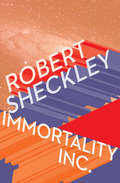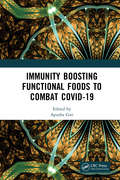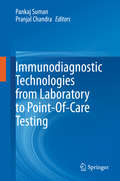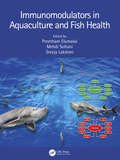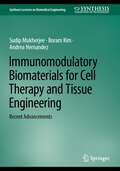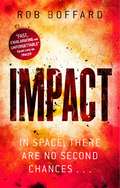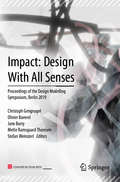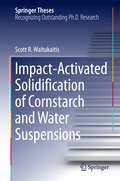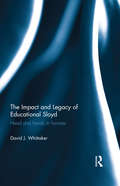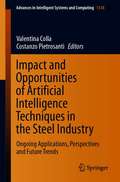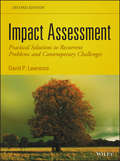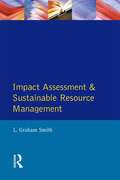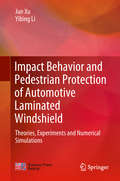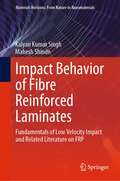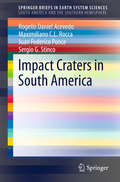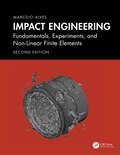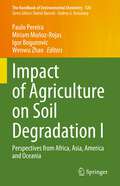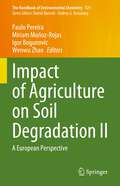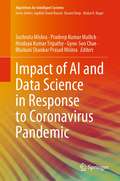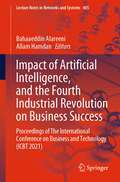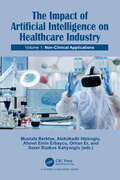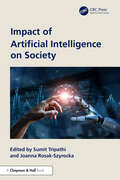- Table View
- List View
Immortality Inc.
by Robert SheckleyA man wakes up after a fatal car accident—in someone else&’s body—in this ahead-of-its-time Hugo Award–nominated classic. Thomas Blaine remembered the car accident that killed him—and then he woke up in the hospital. A nurse told him where he was. &“You&’d call it being in the future.&” A future where bodies are sold to the highest bidder as new homes for the minds of the rich, who are greedy for more life when their own bodies wear out or are damaged. Suddenly, keeping body and soul together has taken on a new, and very sinister, meaning. From the very beginning of his career, Robert Sheckley was recognized by fans, reviewers, and fellow authors as a master storyteller and the wittiest satirist working in the science fiction field. Open Road is proud to republish his acclaimed body of work, with nearly thirty volumes of full-length fiction and short story collections. Rediscover, or discover for the first time, a master of science fiction who, according to the New York Times, was &“a precursor to Douglas Adams.&”
Immunity: How Elie Metchnikoff Changed the Course of Modern Medicine
by Luba VikhanskiAround Christmas of 1882, while peering through a microscope at starfish larvae in which he had inserted tiny thorns, Russian zoologist Elie Metchnikoff had a brilliant insight: what if the mobile cells he saw gathering around the thorns were the same as white blood cells that traveled to the site of an injury or infection in a human or other animal? Was this some form of cellular defense? Metchnikoff's theory of immunity, that phagocytes--white blood cells--formed the first line of defense against invading bacteria would eventually earn the scientist the unofficial moniker "Father of Natural Immunity" and a Nobel Prize. But first, he had to convince his colleagues, including the skeptical Robert Koch. Author Luba Vikhanski chronicles Metchnikoff's remarkable life, work, and discoveries in Immunity, the first modern biography of this hero of medicine. Metchnikoff was a towering figure in the scientific community of the early 20th century, a tireless humanitarian who worked to curb cholera, syphilis, and other diseases, and pioneered research into probiotics and gerontology. Though Metchnikoff is largely forgotten today, Vikhanski makes a compelling case that his work on natural immunity is finally receiving the attention it deserves.
Immunity Boosting Functional Foods to Combat COVID-19
by Apurba GiriIn this book, several functional foods or food ingredients, their mechanism of immune enhancing properties and use in food products have been discussed through seventeen chapters written by eminent authors. There are several medicinal plants which have significant role for immunity boosting such as Ashwagandha, Tulsi, Shatavari, Giloy, Aloe vera, Amla, Neem, licorice, garlic, ginger, turmeric, rosemary, black cumin, cinnamon, sage, thyme,fenugreek, peppermint, black pepper, clove etc. These have been discussed in detail.Note: T&F does not sell or distribute the hardback in India, Pakistan, Nepal, Bhutan, Bangladesh and Sri Lanka.
Immunodiagnostic Technologies from Laboratory to Point-Of-Care Testing
by Pankaj Suman Pranjal ChandraThis book presents the timeline of immunodiagnostics evolution, including advancements in immunological/nucleic acid probes, assay design, labelling techniques, and devices for signal transduction and acquisition. In the past few years, enzyme and nanocatalyst-based immune assays have undergone numerous modifications to enhance their sensitivity and potential for automation. Further, to reduce production costs and the use of laboratory animals, engineering small antibodies and nucleic acid probes (aptamers) has become increasingly popular in the development of novel and powerful bioassays. In light of the notable advancements in immunodiagnostics, this book highlights the combined efforts of clinicians, biotechnologists, material scientists, nanotechnologists and basic scientists in a coherent and highly structured way. The book takes readers on the journey of immunodiagnostic technologies, from their introduction to the present.
Immunomodulators in Aquaculture and Fish Health
by Preetham Elumalai Mehdi Soltani Sreeja LakshmiThis reference book provides updated information about different immunomodulators for managing fish health and sustainable aquaculture. Immunomodulators are dietary additives that enhance innate defense mechanisms and increase resistance against specific pathogens and diseases. The book covers the different types of immunostimulants, their modes of action, and their efficacies. It also reviews safety concerns, ethical regulations, limitations, and outreach to farmers. It discusses the application of herbal immunomodulators, antioxidants, pre- and pro-biotics, in disease management. Features:• Reviews the pressing topic of reduction of antibiotic use in aquaculture • Discusses herbal immunomodulators, nutrients, antioxidants and pre- and pro-biotics • Covers the topic of progressive immunomodulation using nanotechnology • Discusses fish health management in the ever-growing aquaculture industry • Includes natural and synthetic immunomodulators The book is meant for researchers and industry experts in aquaculture, fisheries science, and veterinary medicine.
Immunomodulatory Biomaterials for Cell Therapy and Tissue Engineering: Recent Advancements (Synthesis Lectures on Biomedical Engineering)
by Sudip Mukherjee Boram Kim Andrea HernandezThis book presents the recent developments in immunomodulatory biomaterials for cell-based therapies in various diseases, including diabetes, cancer, cardiovascular disease, and bone regeneration. The authors first cover the fundamentals of conventional immunology and immunomodulation, before focusing on the history, advantages, and challenges of cell therapies. Biological cell therapy has gained immense attention for various diseases due to unique advantages it has over chemical drugs regarding cost, ease of production, toxicity, and therapeutic efficacy. However, these cell-based therapies need an inert delivery system that can locally deliver cells and minimally elicit foreign body response. The book discusses the foreign body response to the immunomodulatory biomaterials as well as the current and future strategies for potential mitigation of considerable immune responses toward immunomodulatory biomaterials and devices.
Immunonutrition: Interactions of Diet, Genetics, and Inflammation
by Bharat B. Aggarwal David HeberThe interaction of immune function and nutrition underlies the low-grade chronic inflammation involved in the etiology of many common obesity-associated and age-related chronic disease conditions. This close interaction is the genesis of the term immunonutrition, which represents a new interdisciplinary field of nutritional and medical research. Im
Impact (Outer Earth #3)
by Rob BoffardFollowing Tracer and Zero-G comes Impact, the explosive conclusion to the Outer Earth trilogy - a heart-pounding thriller set in space where the hero moves like lightning and the consequences for failure are deadly. A signal has been picked up from Earth. The planet was supposed to be uninhabitable. But it seems there are survivors down there - with supplies, shelter and running water. Perhaps there could be a future for humanity on Earth after all. Riley Hale will find out soon enough. She's stuck on a spaceship with the group of terrorists that is planning to brave the planet's atmosphere and crash-land on the surface. But when the re-entry goes wrong, Riley ends up hundreds of miles from her companions Prakesh and Carver, alone in a barren wilderness. She'll have to use everything she knows to survive. And all of them are about to find out that nothing on Earth is what it seems . . .
Impact: Proceedings of the Design Modelling Symposium, Berlin 2019
by Christoph Gengnagel Jane Burry Mette Ramsgaard Thomsen Stefan Weinzierl Olivier BaverelThis book reflects and expands on the current trend in the building industry to understand, simulate and ultimately design buildings by taking into consideration the interlinked elements and forces that act on them. Shifting away from the traditional focus, which was exclusively on building tasks, this approach presents new challenges in all areas of the industry, from material and structural to the urban scale. The book presents contributions including research papers and case studies, providing a comprehensive overview of the field as well as perspectives from related disciplines, such as computer science. The chapter authors were invited speakers at the 7th Symposium “Impact: Design With All Senses”, which took place at the University of the Arts in Berlin in September 2019.
Impact!: Asteroids and the Science of Saving the World
by Elizabeth Rusch Karin AndersonAsteroids bombard our atmosphere all the time. Some are harmless, burning up in a flash of light. But others explode with a great sonic boom, smashing windows and throwing people to the ground. Worst of all, some asteroids strike our planet, blasting out massive craters and destroying everything nearby on impact. Follow the award-winning author Elizabeth Rusch into the field with scientists as they search for dangerous asteroids in space, study asteroids that have smashed into the ground, and make plans to prevent an asteroid strike if one ever threatens our planet.
Impact-Activated Solidification of Cornstarch and Water Suspensions
by Scott R. WaitukaitisThis thesis approaches impact resistance in dense suspensions from a new perspective. The most well-known example of dense suspensions, a mixture of cornstarch and water, provides enough impact resistance to allow a person to run across its surface. In the past, this phenomenon had been linked to "shear thickening" under a steady shear state attributed to hydrodynamic interactions or granular dilation. However, neither explanation accounted for the stress scales required for a person to run on the surface. Through this research, it was discovered that the impact resistance is due to local compression of the particle matrix. This compression forces the suspension across the jamming transition and precipitates a rapidly growing solid mass. This growing solid, as a result, absorbs the impact energy. This is the first observation of such jamming front, linking nonlinear suspension dynamics in a new way to the jamming phase transition known from dry granular materials.
The Impact and Legacy of Educational Sloyd: Head and hands in harness
by David J. WhittakerOriginating in Finland in eighteen-sixty-five, Educational Sloyd used handicrafts practised in schools to promote educational completeness through the interdependence of the mind and body. These radical ideas spread throughout Europe and America and had a significant impact on the early development of manual training, manual arts, industrial education and technical education. Today it is generally acknowledged that Educational Sloyd laid the foundations of modern technological education. This book traces the development of Sloyd from its conception by Uno Cygnaeus and the first Sloyd school founded by Otto Salomon, to its enthusiastic take up in Scandinavia and beyond. It examines the debates and controversy which surround the Sloyd system, and considers the transition from ‘hands-on’ craft work to concepts of technology education. Finally, the investigation reveals the lasting legacy of the ideas and practice of Sloyd education, and how it continues to influence technological education. Included in the book: - the foundations of Educational Sloyd - debates, controversy and rival factions - key case studies in Finland and Iceland - the lasting legacy of Sloyd education. This fascinating and comprehensive historical exploration will be of interest to scholars and researchers in the areas of technology education, comparative education and the history of education.
Impact and Opportunities of Artificial Intelligence Techniques in the Steel Industry: Ongoing Applications, Perspectives and Future Trends (Advances in Intelligent Systems and Computing #1338)
by Valentina Colla Costanzo PietrosantiThis book collects perceptions and needs expectations and experiences concerning the application of Artificial Intelligence (AI) and Machine Learning in the steel sector. It contains a selection of themes discussed within the Workshop entitled “Impact and Opportunities of Artificial Intelligence in the Steel Industry” organized by the European Steel Technology Platform as an online event from October 15 until November 5, 2020. The event aimed at analyzing the diffusion of AI technologies in steelworks and at providing indications for future research, development and innovation actions addressing the sector demands. The chapters treat general analyses on transversal themes and applications for process optimization, product quality enhancement, yield increase, optimal exploitation of resources and smart data handling. The book is devoted to researchers and technicians in the steel or AI fields as well as for managers and policymakers exploring the opportunities provided by AI in industry.
Impact Assessment: Practical Solutions to Recurrent Problems and Contemporary Challenges
by David P. LawrenceOffers solutions and best practices to respond to recurrent problems and contemporary challenges in the field Since the publication of the first edition of Environmental Impact Assessment in 2003, both the practice and theory of impact assessment have changed substantially. Not only has the field been subject to a great deal of new regulations and guidelines, it has also evolved tremendously, with a greater emphasis on strategic environmental, sustainability, and human health impact assessments. Moreover, there is a greater call for impact assessments from a global perspective. This Second Edition, now titled Impact Assessment to reflect its broader scope and the breadth of these many changes, offers students and practitioners a current guide to today's impact assessment practice. Impact Assessment begins with an introduction and then a chapter reviewing conventional approaches to the field. Next, the book is organized around recurrent problems and contemporary challenges in impact assessment process design and management, enabling readers to quickly find the material they need to solve tough problems, including: How to make impact assessments more influential, rigorous, rational, substantive, practical, democratic, collaborative, ethical, and adaptive How each problem and challenge-reducing process would operate at the regulatory and applied levels How each problem can be approached for different impact assessment types—sustainability assessment, strategic environmental assessment, project-level EIA, social impact assessment, ecological impact assessment, and health impact assessment How to link and combine impact assessment processes to operate in situations with multiple overlapping problems, challenges, and impact assessment types How to connect and combine impact assessment processes Each chapter first addresses the topic with current theory and then demonstrates how that theory is applied, presenting requirements, guidelines, and best practices. Summaries at the end of each chapter provide a handy tool for structuring the design and evaluation of impact assessment processes and documents. Readers will find analyses and new case studies that address such issues as multi-jurisdictional impact assessment, climate change, cumulative effects assessment, follow-up, capacity building, interpreting significance, and the siting of major industrial and waste facilities. Reflecting current theory and standards of practice, Impact Assessment is appropriate for both students and practitioners in the field, enabling them to confidently respond to a myriad of new challenges in the field.
Impact Assessment and Sustainable Resource Management (Themes In Resource Management)
by L Graham SmithFirmly places impact assessment in the broader context of environmental planning, developing a much-needed integrative approach. The topics covered include: decision making and dispute resolution; the role of environmental law; public policy, administration and publication participation; the nature of planning; impact assessment methodology; the application of impact assessment to frontier developments; linear facilities and waste mana
Impact Behavior and Pedestrian Protection of Automotive Laminated Windshield: Theories, Experiments And Numerical Simulations
by Jun Xu Yibing LiThis book addresses one of the most important components for pedestrian safety in vehicles – laminated windshields. It includes detailed real-world material characterization results for laminated glass and testing methodologies, constitutive models, and step-by-step numerical simulation modeling and simulation methods. As such, the book provides readers a thorough understanding of the mechanical behaviors of laminated glass and windshields. It also presents fundamental test data, analysis methodologies and essential insights into laminated glass safety design and mechanical behavior prediction. The book addresses the needs of researchers, engineers and postgraduate students in the fields of automotive engineering, mechanical engineering and related areas.
Impact Behavior of Fibre Reinforced Laminates: Fundamentals of Low Velocity Impact and Related Literature on FRP (Materials Horizons: From Nature to Nanomaterials)
by Kalyan Kumar Singh Mahesh Shinde^ This highly informative and carefully presented volume highlights the impact behavior of fibre reinforced polymer composites. It begins with a preliminary focus on FRP materials, fabrication processes, micro- and macro- mechanics to calculate FRP laminates properties, damage nodes associated with FRP composites under different loadings. It provides a simple and unified approach to cover aspects of FRP composites behavior with low velocity impact loading. This book offers a valuable guide for those who wish to develop deeper insights into weaving architectures, stacking sequences, fabrication processes, general damage modes associated with FRP composites. It is a useful volume for students, academia and industry alike.^
Impact Craters in South America
by Rogelio Daniel Acevedo Maximiliano C. L. Rocca Juan Federico Ponce Sergio G. StincoA complete and updated catalogue of impact craters and structures in South America from 2014 is presented here. Approximately eighty proven, suspected and disproven structures have been identified by several sources in this continent. All the impact sites of this large continent have been exhaustively reviewed: the proved ones, the possible ones and some very doubtful. Many sites remain without a clear geological "in situ" confirmation and some of them could be even rejected. Argentina and Brazil are leading the list containing almost everything detected. In Bolivia, Chile, Colombia, Guyana, Paraguay, Perú, Uruguay and Venezuela only a few were observed. Only Ecuador is waiting for new discoveries. So far, the largest well stated impact site is still the Araguainha structure in Brazil with its 40 kilometers in diameter. However, two possible impact structures are larger than Araguainha: Malvinas, (with 250 kilometers in diameter) and Vichada in Colombia, (50 kilometers). This study also reports the existence of some Tertiary-Quaternary glassy impactite layers: the "escorias" and "tierras cocidas" of the pampas in Argentina.
Impact Engineering: Fundamentals, Experiments, Nonlinear Finite Elements
by Marcílio AlvesThis second edition of Impact Engineering covers the dynamic analysis of structures undergoing small to large displacements, linear and nonlinear elastic material behavior to viscoplasticity, and the range of features of structural impact analysis.Individuals, as well as various governing bodies are concerned about protection against natural hazards, crash-type accidents, and terrorism- commonly referred to as "impact"- implying a rapid loading process. The book discusses the physics involved in such impact situations and incorporates analytical considerations as well as techniques to obtain and interpret experimental data and relevant numerical techniques. It also includes a chapter on scaling which is a relevant aspect when studying impact on large structures.This book will be useful for advanced students and professionals in civil and mechanical engineering as well as for students and researchers in applied physics and other relevant disciplines.
Impact of Agriculture on Soil Degradation I: Perspectives from Africa, Asia, America and Oceania (The Handbook of Environmental Chemistry #120)
by Paulo Pereira Miriam Muñoz-Rojas Igor Bogunovic Wenwu ZhaoThis is the first of two volumes that together provide a global overview of the impact of agriculture on soil degradation, tracing the most critical drivers like the use and abuse of agrochemicals, mechanization, overgrazing, irrigation, slash and burn agriculture, and the use of plastics. This book covers the main effects of agriculture practices on soil degradation in several countries from Africa, America, Asia, and Oceania, and it elucidates the impact of chemical agents on soil quality, namely, the use of fertilizers, herbicides, pesticides, soil acidification and microplastics pollution. In these continents, a large number of the population depend on agriculture, which sets an enormous pressure on the ecosystems. Divided into 13 chapters, the book offers authoritative contributions about the fundamental soil degradation problems in countries such as Argentina, Australia, Peru and Bolivia, Brazil, Chile, China, Colombia, India, Israel, Kenya, Mexico, South Africa, the United States of America. As soil degradation issues are often linked with biodiversity loss and poverty, readers will also find in this book an important discussion of the different social, economic, political, and environmental aspects contributing to soil quality and sustainable management. Given the breadth and depth of its coverage, the book offers an invaluable source of information for researchers, students, environmental managers and policymakers alike.
Impact of Agriculture on Soil Degradation II: A European Perspective (The Handbook of Environmental Chemistry #121)
by Paulo Pereira Miriam Muñoz-Rojas Igor Bogunovic Wenwu ZhaoThis is the second of two volumes that together provide a global overview of the impact of agriculture on soil degradation, tracing the most critical drivers like the use and abuse of agrochemicals, mechanization, overgrazing, irrigation, slash and burn agriculture, and the use of plastics.Soil degradation caused by agriculture practices is a complex issue which depends on the interaction of social, economic, political, and environmental aspects. In this book, expert contributors elucidate the extension of the effects of agriculture on soil degradation in Europe, a continent with different cultures and political backgrounds that affect agricultural practices. Readers will also find in this book authoritative solutions to minimize the effects of agriculture intensification and land-use in this continent. Divided into 12 chapters, the book offers a European perspective on soil quality and sustainable management, including case studies about the impact of chemical agents like fertilizers, herbicides, pesticides, and soil acidification and microplastics pollution in agriculture practices from countries such as Croatia, Czech Republic, Estonia, Latvia and Lithuania, Germany, Portugal and Greece, Hungary, Iceland, Italy, Slovenia, Spain, Sweden, and Ukraine. Given the breadth and depth of its coverage, the book offers an invaluable source of information for researchers, students and environmental managers alike.
Impact of AI and Data Science in Response to Coronavirus Pandemic (Algorithms for Intelligent Systems)
by Sushruta Mishra Pradeep Kumar Mallick Hrudaya Kumar Tripathy Gyoo-Soo Chae Bhabani Shankar Prasad MishraThe book presents advanced AI based technologies in dealing with COVID-19 outbreak and provides an in-depth analysis of variety of COVID-19 datasets throughout globe. It discusses recent artificial intelligence based algorithms and models for data analysis of COVID-19 symptoms and its possible remedies. It provides a unique opportunity to present the work on state-of-the-art of modern artificial intelligence tools and technologies to track and forecast COVID-19 cases. It indicates insights and viewpoints from scholars regarding risk and resilience analytics for policy making and operations of large-scale systems on this epidemic. A snapshot of the latest architectures, frameworks in machine learning and data science are also highlighted to gather and aggregate data records related to COVID-19 and to diagnose the virus. It delivers significant research outcomes and inspiring new real-world applications with respect to feasible AI based solutions in COVID-19 outbreak. In addition, it discusses strong preventive measures to control such pandemic.
Impact of Artificial Intelligence, and the Fourth Industrial Revolution on Business Success: Proceedings of The International Conference on Business and Technology (ICBT 2021) (Lecture Notes in Networks and Systems #485)
by Bahaaeddin Alareeni Allam HamdanThis book constitutes the refereed proceedings of the International Conference on Business and Technology (ICBT2021) organized by EuroMid Academy of Business & Technology (EMABT), held in Istanbul, between 06–07 November 2021. In response to the call for papers for ICBT2021, 485 papers were submitted for presentation and inclusion in the proceedings of the conference. After a careful blind refereeing process, 292 papers were selected for inclusion in the conference proceedings from forty countries. Each of these chapters was evaluated through an editorial board, and each chapter was passed through a double-blind peer-review process.The book highlights a range of topics in the fields of technology, entrepreneurship, business administration, accounting, and economics that can contribute to business development in countries, such as learning machines, artificial intelligence, big data, deep learning, game-based learning, management information system, accounting information system, knowledge management, entrepreneurship, and social enterprise, corporate social responsibility and sustainability, business policy and strategic management, international management and organizations, organizational behavior and HRM, operations management and logistics research, controversial issues in management and organizations, turnaround, corporate entrepreneurship, innovation, legal issues, business ethics, and firm gerial accounting and firm financial affairs, non-traditional research, and creative methodologies.These proceedings are reflecting quality research contributing theoretical and practical implications, for those who are wise to apply the technology within any business sector. It is our hope that the contribution of this book proceedings will be of the academic level which even decision-makers in the various economic and executive-level will get to appreciate.
The Impact of Artificial Intelligence on Healthcare Industry: Volume 1: Non-Clinical Applications
by Mustafa Berktas Abdulkadir Hiziroglu Ahmet Emin Erbaycu Orhan Er Sezer Bozkus KahyaogluHealthcare and medical science are inherently dependent on technological advances and innovations for improved care. In recent times we have witnessed a new drive in implementing these advances and innovations through the use of Artificial Intelligence, in both clinical and non-clinical areas.The set of 2 volumes aims to make available the latest research and applications to all, and to present the current state of clinical and non-clinical applications in the health sector and areas open to development, as well as to provide recommendations to policymakers. This volume covers non-clinical applications. The chapters covered in this book have been written by professionals who are experts in the healthcare sector and have academic experience.
Impact of Artificial Intelligence on Society
by Joanna Rosak-Szyrocka Sumit TripathiThe book presents a comprehensive and interdisciplinary exploration of the impact of AI on various sectors of society to foster a greater understanding of the opportunities and challenges presented by this transformative technology. It explores the impact AI has had on varied sectors of society, including healthcare, education, the workplace, and the economy. It provides a holistic view of this fast-growing technology by critical study of the possible benefits and drawbacks linked with the application of AI in many industries. The book also examines the ethical, social, and economic implications of AI and the potential risks and challenges associated with its use. Focuses on the future influence of AI, providing insights into how it could disrupt several industries and change the way we live, work, and connect with one another Explores how AI can be used to tackle global issues such as climate change, food security, and public health concerns Offers case studies and specific examples of how artificial intelligence is being employed in many industries, covering both successes and failures Investigates cutting-edge technology breakthroughs in AI and how they can be used to improve efficiency, productivity, and performance across multiple industries Understands the limitations and potential biases of artificial intelligence, as well as the significance of human monitoring and accountability The book is intended for researchers, practitioners, policymakers, and students who are interested in understanding the nature and role of AI with regard to different sectors of society.
